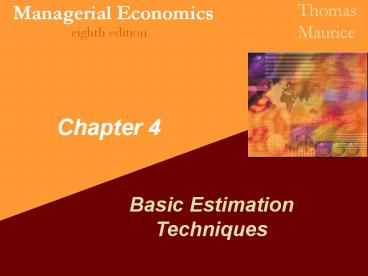Basic Estimation Techniques - PowerPoint PPT Presentation
Title:
Basic Estimation Techniques
Description:
Chapter 4 Basic Estimation Techniques Simple Linear Regression Method of Least Squares Sample Regression Line (Figure 4.2) Unbiased Estimators The distribution ... – PowerPoint PPT presentation
Number of Views:377
Avg rating:3.0/5.0
Title: Basic Estimation Techniques
1
Chapter 4
- Basic Estimation Techniques
2
Simple Linear Regression
- Simple linear regression model relates
dependent variable Y to one independent
(or explanatory) variable X
3
Method of Least Squares
- The sample regression line is an estimate of
the true regression line
4
Sample Regression Line (Figure 4.2)
S
70,000
Sales (dollars)
60,000
50,000
40,000
30,000
20,000
10,000
A
0
8,000
2,000
10,000
4,000
6,000
Advertising expenditures (dollars)
5
Unbiased Estimators
- The distribution of values the estimates might
take is centered around the true value of the
parameter - An estimator is unbiased if its average value (or
expected value) is equal to the true value of the
parameter
6
Relative Frequency Distribution (Figure 4.3)
1
0
8
2
10
4
6
1
3
5
7
9
7
Statistical Significance
- Must determine if there is sufficient statistical
evidence to indicate that Y is truly related to X
(i.e., b ? 0)
- Test for statistical significance using t-tests
or p-values
8
Performing a t-Test
- First determine the level of significance
- Probability of finding a parameter estimate to be
statistically different from zero when, in fact,
it is zero - Probability of a Type I Error
- 1 level of significance level of confidence
9
Performing a t-Test
- Use t-table to choose critical t-value with n k
degrees of freedom for the chosen level of
significance - n number of observations
- k number of parameters estimated
10
Performing a t-Test
- If absolute value of t-ratio is greater than the
critical t, the parameter estimate is
statistically significant
11
Using p-Values
- Treat as statistically significant only those
parameter estimates with p-values smaller than
the maximum acceptable significance level - p-value gives exact level of significance
- Also the probability of finding significance when
none exists
12
Coefficient of Determination
- R2 measures the percentage of total variation in
the dependent variable that is explained by the
regression equation - Ranges from 0 to 1
- High R2 indicates Y and X are highly correlated
13
F-Test
- Used to test for significance of overall
regression equation - Compare F-statistic to critical F-value from
F-table - Two degrees of freedom, n k k 1
- Level of significance
- If F-statistic exceeds the critical F, the
regression equation overall is statistically
significant
14
Multiple Regression
- Uses more than one explanatory variable
- Coefficient for each explanatory variable
measures the change in the dependent variable
associated with a one-unit change in that
explanatory variable
15
Quadratic Regression Models
- Use when curve fitting scatter plot is ?-shaped
or ?-shaped
16
Log-Linear Regression Models































